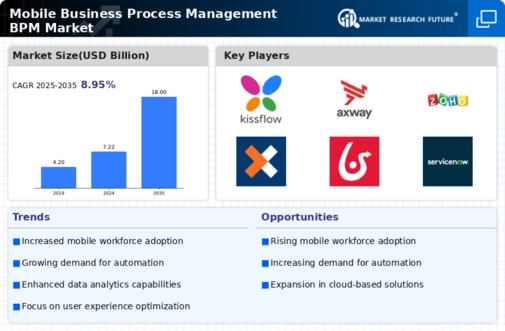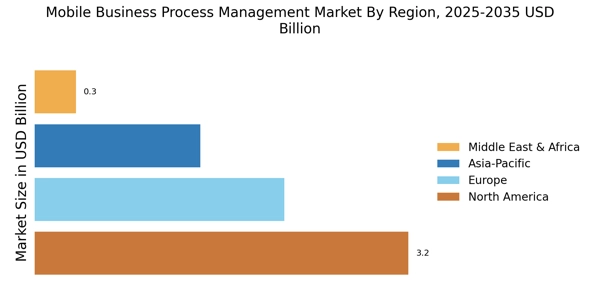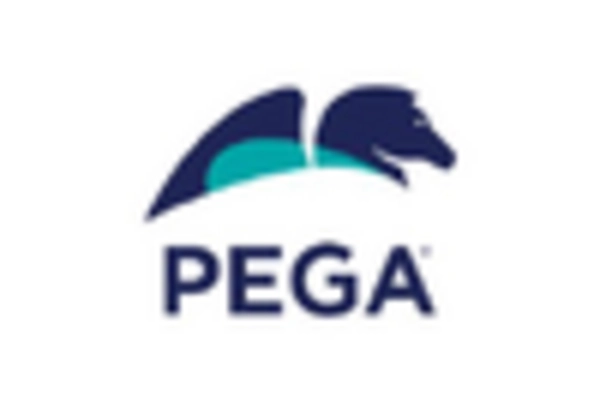Focus on User Experience
User experience has emerged as a critical driver in the Mobile Business Process Management BPM Market. Organizations are increasingly recognizing that a user-friendly interface can significantly enhance employee engagement and productivity. As a result, BPM vendors are prioritizing the design and functionality of their mobile applications. Recent studies indicate that companies that invest in user-centric design see a 20% increase in user adoption rates. This focus on user experience is likely to shape the development of mobile BPM solutions, ensuring they are intuitive and accessible. By improving user experience, organizations can foster a culture of innovation and efficiency, further propelling the growth of the Mobile Business Process Management BPM Market.
Rise of Remote Work Solutions
The Mobile Business Process Management BPM Market is significantly influenced by the rise of remote work solutions. As organizations adapt to flexible work environments, the need for mobile BPM solutions that facilitate seamless collaboration and communication becomes paramount. This trend is underscored by a reported increase in mobile application usage for business processes, with a 30% rise in mobile access to BPM tools noted in recent surveys. Companies are investing in mobile-friendly BPM platforms to ensure that employees can access critical business processes from anywhere, thereby enhancing productivity and responsiveness. This shift not only supports remote work but also drives the demand for innovative mobile BPM solutions that cater to diverse organizational needs.
Demand for Real-Time Data Access
The demand for real-time data access is a pivotal driver in the Mobile Business Process Management BPM Market. Organizations are increasingly reliant on timely information to make informed decisions and respond swiftly to market changes. Mobile BPM solutions that provide real-time analytics and reporting capabilities are becoming essential tools for businesses. According to recent market analyses, the ability to access real-time data can enhance decision-making speed by up to 40%. This trend is pushing organizations to adopt mobile BPM solutions that integrate real-time data access, thereby improving operational efficiency and responsiveness. As businesses continue to seek competitive advantages, the Mobile Business Process Management BPM Market is likely to expand in response to this growing demand.
Integration of Advanced Technologies
The Mobile Business Process Management BPM Market is experiencing a notable shift due to the integration of advanced technologies such as artificial intelligence, machine learning, and the Internet of Things. These technologies enhance process automation, enabling organizations to streamline operations and improve efficiency. For instance, AI-driven analytics can provide insights into process bottlenecks, allowing for timely interventions. The market is projected to grow at a compound annual growth rate of approximately 15% over the next five years, driven by the demand for smarter, more agile business processes. As organizations increasingly adopt these technologies, the Mobile Business Process Management BPM Market is likely to witness a surge in innovative solutions that cater to evolving business needs.
Increased Focus on Compliance and Security
Compliance and security concerns are driving the Mobile Business Process Management BPM Market as organizations strive to protect sensitive data and adhere to regulatory requirements. With the rise of mobile solutions, ensuring data security has become a top priority for businesses. Recent reports indicate that nearly 60% of organizations consider compliance with data protection regulations as a critical factor when selecting BPM solutions. This heightened focus on security is prompting vendors to enhance their offerings with robust security features, such as encryption and multi-factor authentication. As organizations navigate complex regulatory landscapes, the Mobile Business Process Management BPM Market is expected to grow as businesses seek solutions that not only streamline processes but also ensure compliance and security.


















Leave a Comment